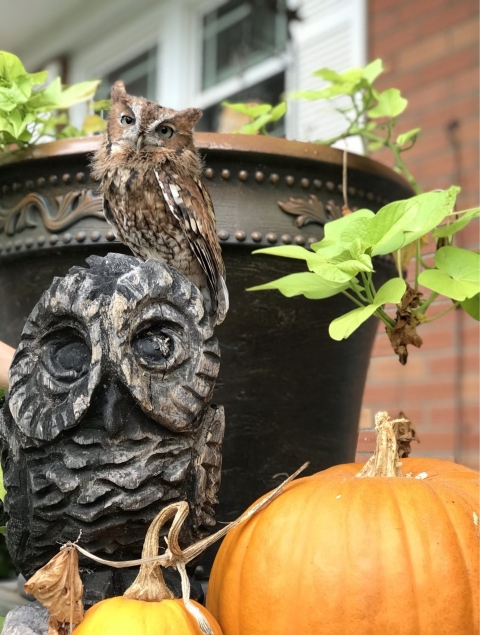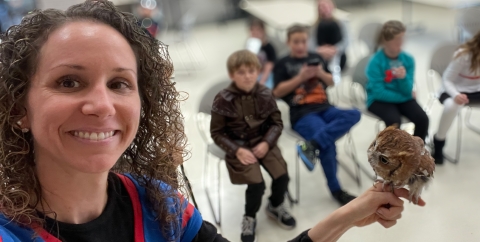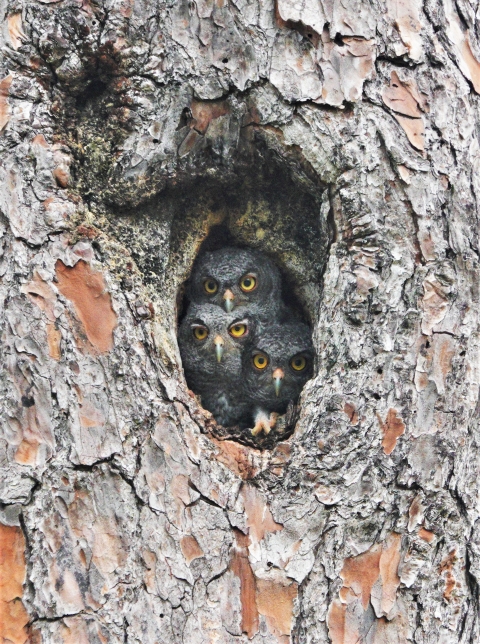Owls are often associated with wisdom, mystery, and nocturnal intrigue. These captivating birds have adaptations that make them some of the most effective hunters in the animal kingdom.
Our Eastern screech-owl ambassador, Luna, lost her ability to hunt because of a window strike. The accident caused a loss of depth perception and balance. Consequently, Luna has a permanent head tilt. It’s her body’s way of adjusting to the losses, but unfortunately, the window strike cost Luna her ability to fly and hunt.
Owls are equipped with several features that make them exceptional hunters:
- Silent Flight: Their specialized wing feathers allow them to fly silently, helping them approach prey without detection.
- Exceptional Hearing: Owls have asymmetrical ear openings, enabling them to pinpoint sounds accurately, even in complete darkness.
- Powerful Eyesight: Owl eyes are adapted for low-light vision, providing excellent sight during twilight and nighttime.
Although Luna lost several owl superpowers, she’s not letting it get her down. Now Luna is pursuing her passion for teaching. The adorable owl teaches people about Eastern screech-owls, often visiting the library, with her best human friend - Educational Specialist Stacey Hayden - for reading time with kids. She also teaches people the importance of stopping bird collisions.
Conservation Status
While many owl species thrive, habitat loss and environmental changes have led to the decline of some populations. Awareness and conservation efforts are essential to protect these remarkable birds and their habitats.
Identifying Features
There are over 200 species of owls worldwide. Here is how to identify an Eastern screech-owl:
- About the size of a robin (roughly 7 inches long).
- Large head and almost no neck.
- Rounded wings
- Tail short and square
- Mostly grey or reddish brown with bands and spots that act as camouflage against tree bark
- Yellow eyes
- Short "ear" tufts
5 Fast Facts
- Vocalizations: Eastern screech owls have a distinctive, eerie tremolo call that sounds like a horse’s whinny. They can also produce a variety of other sounds, including soft trills and hoots.
- Hollow Nesters: Unlike many other owls that prefer to create their nests, Eastern screech owls often take over abandoned nests of other birds or use tree cavities, making them opportunistic nesters. They also use nest boxes.
- Exceptional Hearing: Owls have asymmetrical ear openings, which enable them to determine the exact location of sounds in three-dimensional space. This acute hearing is crucial for locating prey, even in complete darkness.
- Large Eyes: Owl eyes are large and forward-facing, giving them binocular vision and excellent depth perception. While they can’t move their eyes, they can rotate their heads up to 270 degrees to see in different directions.
- Regurgitated Pellets: Owls have a unique way of digesting their food. They swallow their prey whole and later regurgitate pellets that contain the indigestible parts, such as bones and fur. These pellets can provide valuable information about their diet and hunting habits.
Where can I find Eastern screech-owl?
You can meet Luna at Clarks River National Wildlife Refuge, in Benton, KY, or follow them on Facebook to see Luna updates.
In the wild, owls can be hard (not impossible) to spot because they are nocturnal. They can be seen East of the Rocky Mountains in wooded areas near parks.
Here is a list of National Wildlife Refuges that you can visit after dark, when it’s best to spot owls:
- Okefenokee NWR (offers overnight camping)
- Umbagog NWR (offers overnight camping)
Eastern screech-owl Photo Contest
As part of our Bird of the Month series, we invite you to submit your photos of Eastern screech-owls in a photo contest.
**In the file name of your photo, please include your first and last name, contact email address, and the location where the photo was taken. If these components are missing, we will have no way of contacting you if you win. **
Submissions will be judged by a panel of U.S. Fish and Wildlife Service employees. Once a winner is selected, they will be contacted via email and asked to sign a photo release form. This form protects the photographer's rights, ensures proper credits are given, and grants the U.S. Fish and Wildlife Service permission to share the photo on our social media channels. Please monitor your junk/spam folders towards the end of the month in the event that we reach out and our email lands there.
The winner will be announced publicly near the end of each month on our Southeast Regional Facebook and X (formerly known as Twitter) platforms.
A photo contest will occur each month for each featured bird species. At the end of 2024, all twelve winning photographs will be shared on our regional social media accounts.
Submit your original photos of Eastern screech-owls here!











